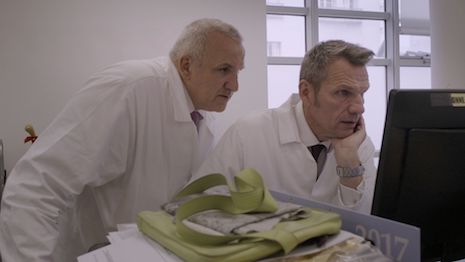 Hermès is focusing on the people who have been impacted by its activities. Image credit: Hermès
Hermès is focusing on the people who have been impacted by its activities. Image credit: Hermès
French fashion house Hermès is documenting its global impact on people through stories of creation and progress.
The brand’s “Footsteps Around the World” series highlights workers in Hermès production facilities and those who have benefited due to outreach from its eponymous foundation or corporate funds. Putting a human face to corporate social responsibility may help consumers gain a better understanding of who and how Hermès helps.
"Brands evolve through a two-way communication system," said Thomai Serdari, a professor of luxury business marketing at New York University, New York. "Messages go out to the world while contextual information is coming in.
"A major part of all discussions in fashion and luxury today focuses on sustainability," she said. "It is imperative therefore for a brand to explain what processes have been established to help keep it sustainable.
"At Hermès, sustainability both from the perspective of craft preservation and from that of economic development constitutes one of the fundamental pillars of the brand. The time came for Hermès to highlight issues that are top-of-mind for most consumers today."
Ms. Serdari is not affiliated with Hermès, but agreed to comment as an industry expert. Hermès was reached for comment.
Following Hermès' footsteps
For Footsteps Across the World, Hermès tapped documentary filmmaker Frédéric Laffont.
Shared as a series on the brand’s social channels and its Web site, the collection of films takes viewers to destinations in Hermès’ native France as well as the United Kingdom and Burkina Faso.
In Patin, France, Mr. Laffont captured Lionel and André Prudhomme, who work at the brand’s leather workshop as foremen. Nicknamed the “Blouse Brothers” for the white lab coats they wear, the siblings have each worked for the company for about four decades.
The brothers discuss their work training craftsmen and their long-term relationship with the house.
Hermès’ series also travels to Montbron, France to tell the story of the people employed by its factory there. The rural community was struggling with disappearing jobs, but the opening of an Hermès manufacture turned the town around, creating 250 new jobs.
Hermès brought jobs to Montbron, France. Image credit: Hermès
Employees talk about the difference it has made, by allowing them to stay in town or work closer to home.
In London, the series tells the story of The Goldfinger Factory, which is supported by the Fondation d’entreprise Hermès. This workshop, located in Trellick Tower in an underprivileged part of West London, trains apprentices in artisanship as they make furniture out of recycled metal and wood.
Footsteps Across the World also travels to Kongussi, Burkina Faso, where cooking was a dangerous and uncomfortable task. Open fires could cause houses to go up in flames, while women would breathe in smoke as they prepared meals.
Hermès Footsteps Across the World in Kongussi
Through the Livelihoods fund, Hermès supports an initiative to teach women how to build stoves out of a cooking pot, termite mound, straw and dung. The resulting fuel-efficient stoves reduce the amount of wood needed for cooking, saving forests and reducing women’s work collecting branches.
"The series primarily isolates specific areas in which Hermès has been groundbreaking to ultimately bring out the humanistic profile of the firm, a differentiation point that only very few luxury brands can claim to cultivate," Ms. Serdari said. "The type of information communicated through this series is not new to those who know the brand well, but it is told in a compelling and contemporary form of storytelling that keeps the viewer engaged.
"Beyond informing the viewer, the series aims to educate the public not only on what Hermès has been striving to achieve in these areas but also on the most important issues that should inform contemporary fashion and luxury practice in the marketplace."
CSR commitment
In a world where facts and figures are increasingly called into question, luxury brands will need to lead with emotion and values rather than rationality to succeed.
According to a new report from Positive Luxury, while storytelling and truth were the buzzwords of 2016 and 2017, respectively, 2018 will be dominated by the concept of “influence through emotion.” As millennials’ spending power grows, their preference for companies and brands that strive for environmental and social good is moving the needle for luxury brands, making CSR a boon for business (see story).
Ethical and purpose-based business practices are quickly becoming brand identifiers, on par with quality, craftsmanship and service, as luxury buyers turn increasingly conscious of their environmental footprint.
Transparent sustainability and corporate social responsibility (CSR) policies are much more than a passing trend or a once-per-year obligation mentioned only on Earth Day – these measures have become luxury’s new cornerstones. With heightened eco-friendly awareness stemming primarily from millennials, luxury brands must approach CSR as a non-negotiable service to society, rather than a public relations-motivated stunt (see story).
"The more information a brand shares, the more transparent it becomes," Ms. Serdari said. "This helps strengthen the bond between the brand and its consumers, increases their loyalty and ultimately contributes to the brand’s equity.
"Let’s not forget that what makes a brand work is its people. In the case of Hermès, these people are particularly gifted individuals, committed to their craft and to learning," she said. "They are also committed to leaving a legacy that can sustain future generations in their quest to find a job, do it well and do it from a place of pride and inspiration.
"The profiles highlighted in the series are exemplary in the humanistic value they contribute through their well crafted products to the world. In that sense, the series is another way of recounting the message that forms the core of Hermès, namely that this is a luxury brand committed to the idea of craft heritage and one that sees itself as a facilitator in the process of transmitting ideas, skills and processes to future generations.
"Simply put, the humanistic role the brand has responsibly assumed is that of catalyst of innovation within traditional craft professions. This powerful identity builds community both within and without. It addresses those who aspire to positively contribute to sustaining cultural heritage through economic opportunities for craft workers and the consumers who desire these culturally rich products."
